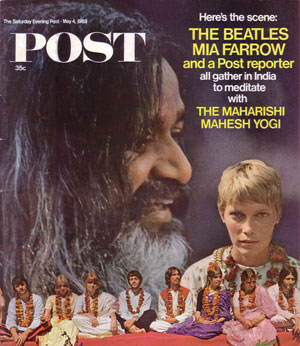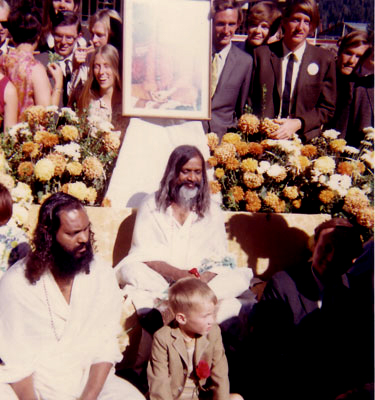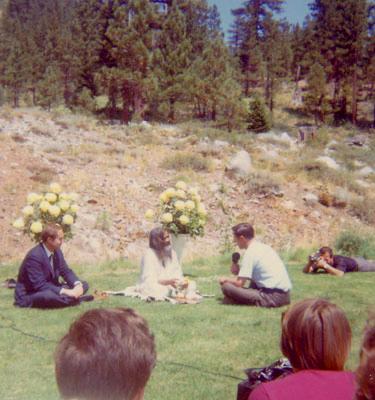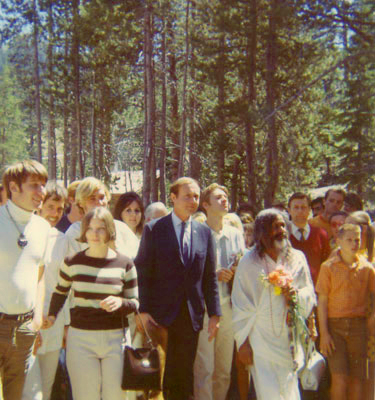Maharishi Mahesh Yogi and Transcendental Meditation
Wisdom from India and an alternative to drugs
In early 1968, the Beatles went to India to study Transcendental Meditation (TM) with Maharishi Mahesh Yogi. Although they left before the course was over, they attracted numerous reporters and photographers to the scene, which resulted in several cover stories in national magazines and a wave of interest throughout the world. The fact that Mia Farrow, Donovan, and Mike Love of the Beach Boys were also there didn’t hurt, but the reasons for the popularity of Maharishi and TM went far beyond the desire to emulate celebrities.

Maharishi had first come to the United States in 1959, following thirteen years of studying with his spiritual leader Guru Dev, and subsequent years of teaching meditation in India. He had traveled through Burma, Malaya, Singapore, Hong Kong, Hawaii, and San Francisco before arriving in Los Angeles and giving his first lecture at the Masquers Club, an actors’ club in Hollywood. He developed a devoted following in the L. A. region, and the Spiritual Regeneration Movement was founded to help further the spread of Transcendental Meditation. Maharishi continued to travel the world with his teaching, and in 1965 the Students’ International Meditation Society (SIMS) was established.
College students had discovered TM, and 1968 was the year that really saw the movement blossom. Transcendental Meditation is a simple, teachable meditation technique that requires no concentration or contemplation. It is easy, and requires only twenty minutes twice a day to gain the benefits of stress release, relaxation, increased energy, and a sense of well-being. Students were attracted by these benefits, and by the almost mystical qualities of Maharishi himself. His lectures at college campuses across the country had brought many people back for initiation, the process for learning the technique. They would tell their friends, and urge them to attend the next lecture. Maharishi had established an academy of meditation in India, and the more devoted of his followers attended the academy and become teachers of TM. As interest grew, these teachers were able to instruct increasing numbers of students back home.
In 1967, after widespread national publicity including an appearance on the Johnny Carson show, the movement had already grown to include 50 centers worldwide. Some 250,000 meditators had already learned the technique, and interest was running high. The Beatles (accompanied by Mick Jagger) had gone to Bangor, North Wales, in late August 1967 to hear a lecture by Maharishi and learn the technique. Their visit was shattered by the news that their manager, Brian Epstein, had died from an overdose of sleeping pills. Maharishi helped them deal with their grief, and they soon made plans to go to Rishikesh, India, for the next teacher-training course starting in February 1968. Prior to starting TM, the Beatles and large numbers of young people had been smoking marijuana, and many had also taken the hallucinogenic drug LSD. This often led to a feeling of loss of control, and a risk of burning out. The Beatles weren’t the only ones looking for a way to back off from these drugs. Maharishi required that each person who wanted to start TM be free of all such drugs for at least two weeks prior to learning the technique, which was a major challenge for many students. The Beatles and all the other celebrities who became associated with TM gave thousands of people a socially-acceptable excuse to get away from drugs and the drug culture while remaining part of the wider camaraderie of involved youth. It also brought the generations together in a way that few other 60’s themes could.
Maharishi’s followers were a fairly eclectic group. The director of the Students’ International Meditation Society was Jerry Jarvis, who was 35 in 1968. He had already been spreading the word about TM for some years, and he helped S.I.M.S. to grow throughout the U.S. He led a meditation course for 300 students at Asilomar in California in December 1967, and orchestrated a course in Squaw Valley in August 1968, taught by Maharishi himself. For a month, meditators from all walks of life listened to several lectures a day, meditated, and enjoyed the company of a diverse group of people who were brought together by their enthusiasm for TM. Occasionally one even caught a glimpse of a celebrity in Squaw Valley.

Maharishi’s basic message was the importance of practicing TM. "If more people meditated, the world would be a better place. Meditation brings peace and harmony to one’s life, and reduces stress. If one meditates regularly, life becomes better automatically. During the course, he clarified the understanding of the technique: TM allows the conscious mind to experience the source of thought. Daily experience of TM brings this awareness into daily life. Sitting quietly while meditating brings increased energy to daily life in the same way that pulling an arrow back to a still place on the bow allows for the release of great energy when the arrow is shot forward."
Maharishi also spoke of the importance of honoring one’s parents (a concept that had become a bit strained in the late 60’s). He felt that the best way to ensure the credibility of the movement included dressing conservatively. When asked why he did not dress in Western clothing, he replied that he dressed appropriately for his culture, and Americans should follow their own culture. For students looking for insights from Eastern religions, or something exotic to study besides psychedelia, the study of TM became a source of satisfaction--though the actual practice of TM does not require study. When the course was over, these students returned to their colleges to help spread the teaching of TM.
Many students persuaded their parents, as well as their friends, to learn the technique. Reaction by the “establishment” to Maharishi was mixed. Some people were cynical about anything the youth culture endorsed, and parodies of Maharishi cropped up in comedy routines. Other Eastern mystics or gurus were often confused with Maharishi, so he sometimes bore the brunt of criticism meant for others. Yet many people who were not interested in trying drugs were comfortable learning the natural high of TM. The TM movement attracted a wide cross-section of the population. Meditators were of all ages, religions, income levels, and professions. For many people over 30, TM was as close as they got to being a part of the counter-culture of the 60’s. Maharishi carried flowers, wore exotic clothing and a string of beads, got a lot of media attention, and spoke of peace and love. The Students’ International Meditation Society made the technique of TM accessible to almost anyone who was interested, and in 1968 that included a large and diverse group of people throughout the world.

After the course in Squaw Valley, Maharishi was off to Singapore, Kuala Lumpur, Bangkok, and another tour of India. In June, he had been to Argentina, Australia, and Tahiti. The November 1968 Newsletter from the Academy of Meditation in Rishikesh described his visit to Tahiti thus: “Maharishi arrived in Sydney from Argentina two days behind schedule as his plane was delayed in Tahiti, where he was to have stayed overnight in transit. However, this afforded the people of Tahiti the opportunity of hearing about Transcendental Meditation, and Maharishi gave a public lecture, after which he initiated many people into the technique. We now have a new center in Tahiti.” Many capable people were enchanted with Maharishi and his message, and they flocked to his aid. Many were volunteers, and some were given jobs with the organization as the movement grew. The scientific studies about the physiological results of practicing TM, published in the early 70’s, were not yet available, but people relied on their own experience and typically liked what they felt. |
|